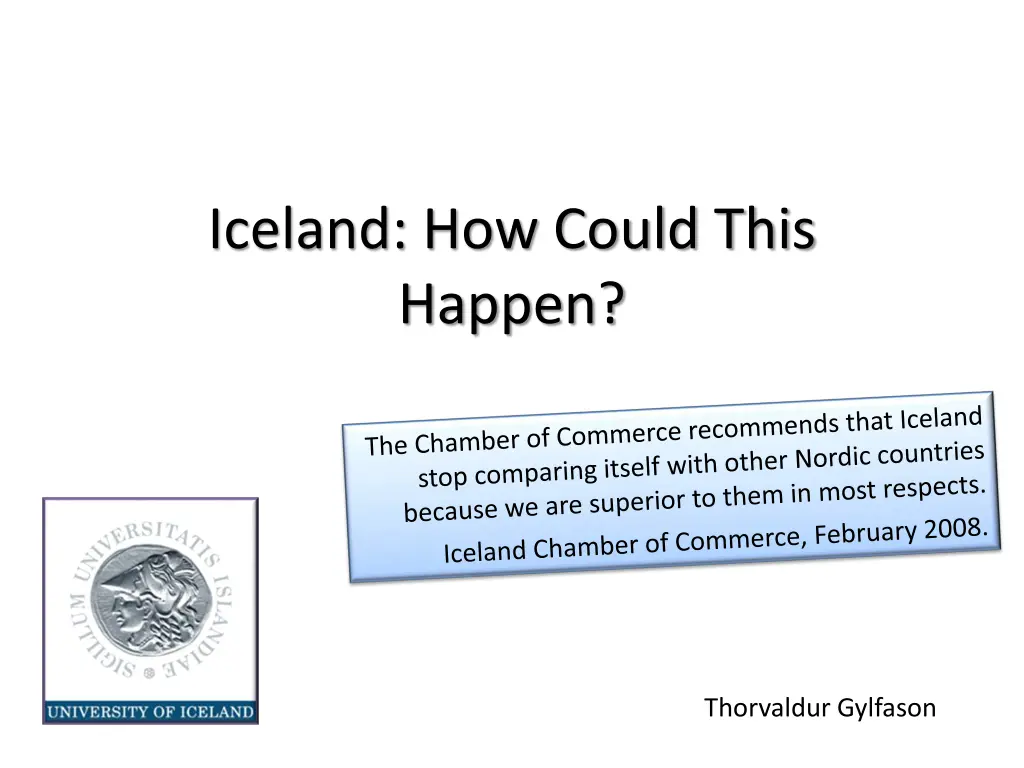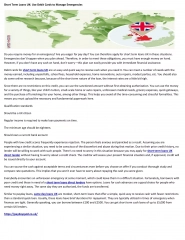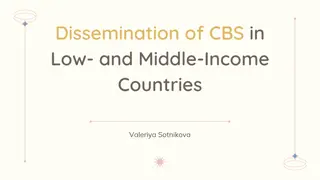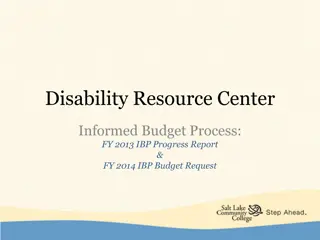
Iceland's Economic Challenges: An In-depth Analysis
Explore the historical background and current economic situation of Iceland along with comparisons to other Nordic countries and European peers. Delve into factors like GNI per capita, hours of work, unemployment rates, and inflation trends to understand the complexities of Iceland's economic landscape.
Download Presentation

Please find below an Image/Link to download the presentation.
The content on the website is provided AS IS for your information and personal use only. It may not be sold, licensed, or shared on other websites without obtaining consent from the author. If you encounter any issues during the download, it is possible that the publisher has removed the file from their server.
You are allowed to download the files provided on this website for personal or commercial use, subject to the condition that they are used lawfully. All files are the property of their respective owners.
The content on the website is provided AS IS for your information and personal use only. It may not be sold, licensed, or shared on other websites without obtaining consent from the author.
E N D
Presentation Transcript
Iceland: How Could This Happen? Thorvaldur Gylfason
Overview Historical background Relevant comparisons Denmark, Finland, Norway, and Sweden Ireland, Portugal, and Greece Faroe Islands Gathering clouds, once more Weakened institutions, failed banks, broken trust: Deep trouble Uncertain prospects for reform and restoration
GNI per capita (1980-2012, current international $, ppp) Nordics Periphery 70000 45000 Greece Denmark 40000 60000 Iceland 35000 Finland Ireland 50000 30000 Iceland Portugal 40000 25000 Norway 20000 30000 Sweden 15000 20000 10000 10000 5000 0 0 Source: World Bank World Development Indicators.
Hours of work per employee 1950-2012 Nordics Periphery 3000 3000 2500 2500 2000 2000 1500 1500 Denmark Greece Iceland Finland 1000 1000 Ireland Iceland Portugal Norway 500 500 Sweden 0 0 Source: The Conference Board Total Economy Database , January 2013, http://www.conference-board.org/data/economydatabase/
Hours of work per capita 1950-2012 Nordics Periphery 1800 1800 1500 1500 1200 1200 900 900 Greece Denmark Iceland Finland 600 600 Iceland Ireland Norway Portugal 300 300 Sweden 0 0 Source: Author s computations based on preceding charts.
GNI per hour worked 1990-2012 (Current international $, ppp) Nordics Periphery 80 80 Denmark Greece 70 70 Finland Iceland 60 60 Iceland Ireland 50 50 Norway Portugal 40 40 Sweden 30 30 20 20 10 10 0 0 Source: Author s computations based on preceding charts.
Unemployment (1980-2011, % of labor force) Nordics Periphery 20 20 Greece Denmark 18 18 Iceland Finland 16 16 Ireland Iceland 14 14 Norway Portugal 12 12 Sweden 10 10 8 8 6 6 4 4 2 2 0 0 Source: World Bank World Development Indicators.
Inflation (1961-2012, consumer prices, % per year) Nordics Periphery Iceland: Missed inflation target 90 90 20 Greece % per year CPI Denmark 15 80 80 CBI Inflation target Iceland Finland 10 70 70 Iceland Ireland 5 60 60 Norway Portugal 0 50 50 Sweden 40 40 30 30 20 20 10 10 0 0 -10 -10 Source: World Bank World Development Indicators.
Banking Three main banks and Central Bank collapsed Recapitalization of three commercial banks cost 18% of GDP Recapitalization of Central Bank cost 18% of GDP Damage incurred equaled seven times GDP Foreign creditors, shareholders, and depositors lost five times GDP Local residents lost two times GDP (stock market was wiped out, pension funds took a big hit) Public debt rose from 29% to 93% of GDP, or by 64% of GDP close to world record
Banking Banks broke the law (SIC report 2010) Insider trading Market manipulation False reporting Breach of trust Foreign-currency indexed loans Local-currency indexed loans? Special prosecutor s office set up in 2009 Staff expanded from 3 to 100, with foreign help 80 cases involving nearly 200 individuals
Blacks Recipe for control fraud The Best Way to Rob a Bank is to Own One When a senior officer deliberately causes bad loans to be made he does not defraud himself He defrauds the bank s creditors and shareholders, as a means of optimizing fictional accounting income It pays to seek out bad loans because only those who have no intention of repaying are willing to offer the high loan fees and interest required 1. Grow really fast 2. Make really bad loans at higher yields 3. Pile up debts 4. Put aside pitifully low loss reserves
Banking No banking strategy in place as yet Rumors of Russian money laundering before crash No foreign competition in sight yet Government has a big stake in Landsbanki, smaller stakes in other two banks Rumors of selling stakes to, yes, Chinese banks New government immediately closed down EU accession talks, cozying up instead to China and Russia as well as to Greenland and the Faroe Islands Strict capital controls: No end in sight
Ten largest corporate bankruptcies of all time (USD billion) Source: Financial Supervisory Authority of Iceland.
Bank assets (1990-2011, % of GDP) Nordics 1990-2011 Periphery 1995-2011 1000 1000 Greece Denmark 900 900 Iceland Finland 800 800 Ireland Iceland 700 700 Portugal Norway 600 600 Sweden 500 500 400 400 300 300 200 200 100 100 0 0 Source: World Bank World Development Indicators.
Domestic bank lending 1960-2012 (% of GDP) Nordics Periphery 350 350 Greece Denmark 300 300 Ireland Finland 250 250 Iceland Iceland 200 200 Portugal Norway 150 150 Sweden 100 100 50 50 0 0
Interest rate spread (1961-2009, lending rate minus deposit rate, %) Nordics 1970-2009 Periphery 1961-2005 15 15 10 10 5 5 0 0 -5 -5 Denmark Finland Iceland Norway Sweden Greece Iceland -10 -10 Ireland Portugal -15 -15 Source: World Bank World Development Indicators.
Bank nonperforming loans (2000-2012, % of gross loans) Nordics Periphery 45 45 Greece Denmark 40 40 Iceland Finland 35 35 Ireland Iceland 30 30 Portugal Norway 25 25 Sweden 20 20 15 15 10 10 5 5 0 0 Source: World Bank World Development Indicators.
General government gross debt (2001-2012, % of GDP) Nordics Periphery 180 180 Denmark Greece 160 160 Finland Iceland 140 140 Iceland Ireland 120 120 Norway Portugal 100 100 Sweden 80 80 60 60 40 40 20 20 0 0 Source: Eurostat.
Trust in Icelandic institutions 2013 (% expressing a lot of trust in institutions) MMR Capacent 90 90 80 80 70 70 60 60 50 50 40 40 30 30 20 20 10 10 0 0
Corruption 2012 (Business corruption as measured by Transparency, political corruption as measured by Gallup) Transparency Gallup 100 100 90 90 80 80 70 70 60 60 50 50 40 40 30 30 20 20 10 10 0 0
Exports of goods and services (1960-2012, % of GDP) Nordics Periphery 120 120 Greece 100 100 Iceland Denmark Ireland Finland 80 80 Iceland Portugal Norway 60 60 Sweden 40 40 20 20 0 0 Source: World Bank World Development Indicators.
Import volume 2000-2011 (2000 = 100) Nordics Periphery 200 200 180 180 160 160 140 140 120 120 100 100 Denmark 80 80 Greece Finland 60 60 Iceland Iceland 40 40 Ireland Norway 20 20 Portugal Sweden 0 0 Source: World Bank World Development Indicators.
Manufactures exports (1962-2012, % of total exports) Nordics Periphery 100 100 Denmark Finland Iceland Greece Iceland 90 90 Norway Sweden Ireland Portugal 80 80 70 70 60 60 50 50 40 40 30 30 20 20 10 10 0 0 Source: World Bank World Development Indicators.
Gross capital formation (1965-2011, % of GDP) Nordics Periphery 60 60 Denmark Greece Finland 50 50 Iceland Iceland Norway Ireland 40 40 Sweden Portugal 30 30 20 20 10 10 Iceland: Collapse of net investment 30% 0 0 % of GDP 20% 10% 0% Source: World Bank World Development Indicators. -10%
Adjusted net saving (2005-2012, % of GNI) Nordics Periphery 30 30 Greece Denmark Finland Iceland 25 25 Norway Sweden Iceland 20 20 Ireland 15 15 Portugal 10 10 5 5 0 0 -5 -5 -10 -10 Source: World Bank World Development Indicators.
Labor force with primary education (1992-2011, % of total) Nordics Periphery 90 90 Denmark 80 80 Finland 70 70 Iceland 60 60 Norway 50 50 Sweden 40 40 30 30 20 20 Greece Iceland 10 10 Ireland Portugal 0 0 Source: World Bank World Development Indicators.
Labor force with secondary education (1992-2011, % of total) Nordics Periphery 70 70 Greece 60 60 Iceland Ireland 50 50 Portugal 40 40 Denmark 30 30 Finland Iceland 20 20 Norway 10 10 Sweden 0 0 Source: World Bank World Development Indicators.
Labor force with tertiary education (1992-2011, % of total) Nordics Periphery 45 45 Greece Iceland Denmark Finland 40 40 Iceland Norway Ireland Portugal 35 35 Sweden 30 30 25 25 20 20 15 15 10 10 5 5 0 0 Source: World Bank World Development Indicators.
Periphery: Banking crises vs. fiscal crises Bank assets 2007 (% of GDP) Fiscal measures 2007 (% of GDP) 1000 140 Central government debt 900 120 800 General government expenditure 100 700 600 80 500 60 400 40 300 200 20 100 0 0 Greece Iceland Ireland Portugal Greece Iceland Ireland Portugal In 2012, ca. half of Irish households had negative equity in their houses compared with about a quarter of Icelandic households
Iceland 2008 vs. Faroe Islands 1989 Iceland Faroe Islands Root cause: Corruption, esp. incestuous relations among banks, business, and politics 2009-2010: GDP fell 10% No significant emigration yet, this could change Kr na fell by 33% in real terms Promised constitutional reform, but did not deliver, ignored national referendum Limited trust: From cohesion to contempt Root cause: Corruption, esp. incestuous relations among banks, business, and politics 1989-1993: GDP fell 33% 15% of population fled, a third of which returned later Fixed exchange rate, tied to Danish krone one-to-one Promised constitutional reform, but did not deliver, did not hold national referendum






















